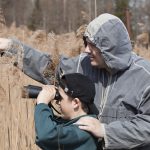The Whitefish Point Bird Observatory, located near Michigan’s Whitefish Point National Wildlife Refuge, is a non-profit education and research facility and a partner of Michigan Audubon Society. WPBO and The Society recorded more than 300 bird species at Whitefish Point. The Canadian Monitoring Migration Network and the WPBO documents the Great Lakes region’s bird population through research studies, data collection and bird banding.
In 1966, a spring hawk banding plan that was expanded shortly for surveillance of migrating owls was incorporated by the bird watchers from the Canbrook Institute of Science and Ontario Bird Banding Association at Whitefish Point. This project was carried out from 1966 until 1971 and was WPBO’s forerunner.
Because of the exposure of the researcher to extreme weather, WPBO took up British observatories’ procedures of using small building structures along the coast’s rocky points to be inhabited by people who examine migrating birds, create records and give observation reports of bird migrations at the stations. The WPBO, together with the Michigan Audubon Society, have recorded more than 300 bird species.
Whitefish Point was designated by The American Bird Conservancy as a globally Important Bird Area. Whitefish Point’s water and land features generate a natural corridor that guides a huge population of birds throughout fall and spring migrations, allowing distinctive opportunities for education, research and conservation programmes. Merlins, Peregrine Falcons, Golden eagles, Great Gray Owls, Boreal Owls, Red-necked Grebes, Jaegers or Skuas, Red-throated Loons and Scoters are the birds seen throughout migration. Several birds utilise Whitefish Point for a stopover habitat for restoration of energy reserves prior to their venture on Lake Superior throughout fall and spring migrations.













